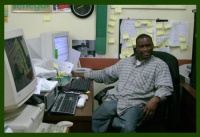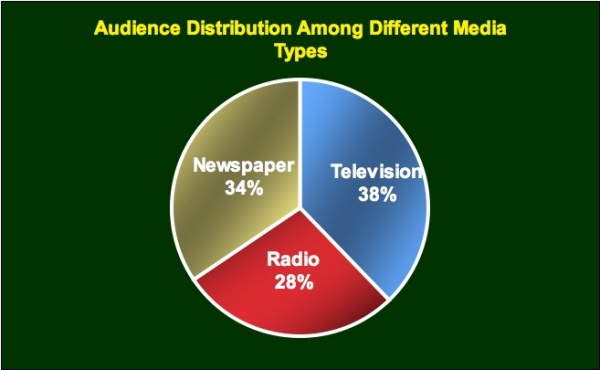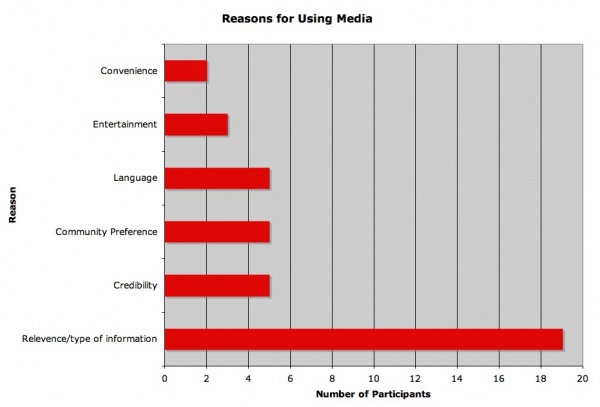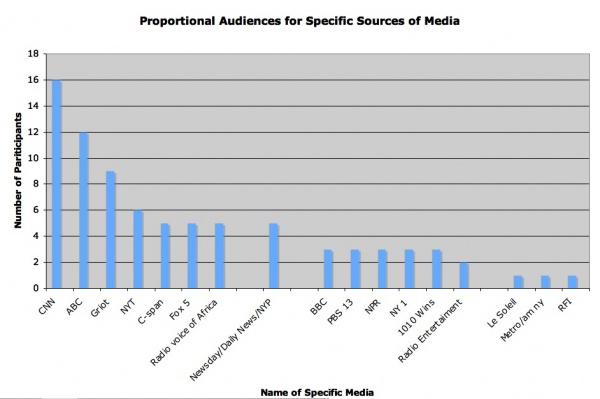Media
From The Peopling of New York City

| ||||||||
|---|---|---|---|---|---|---|---|---|
|
Since media plays a large role in people's lives, we decided to explore how the media affects the Senegalese community. We also wanted to understand the mechanics of the local media, both in content (e.g. format, focus, tone, etc.) and in business (e.g. distribution, advertisements, production, etc.). To this end we observed the media itself, reading newspapers and listening to the radio, and gathered feedback from the community.
The African Sun-TimesThe African Sun-Times is an English-language newspaper widely distributed in Little Senegal. The paper features content from contributors all over Africa, and is generally devoted to African politics. The paper’s tone is startlingly casual, particularly when compared to the strict style guidelines of typical American journalism; spelling errors are not uncommon. Despite this, the paper contains in-depth coverage of events generally ignored by the mainstream media. Additionally, the paper covers various social and domestic issues of special importance to the readers, such as religious issues and local ethnic tensions (for example, the tensions between immigrant Africans and African-Americans with ancestral roots in the U.S.)Le Griot is the major rival of the Sun-Times for influence in the neighborhood. Le Griot is, like the Sun-Times, an African focus paper, but it is written in French. Thus it is more accessible to African immigrants who do not speak English and are more comfortable in Wolof or French, which makes up a large portion of the Senegalese community. While the Sun-Times focuses almost exclusively on politics, Le Griot covers a more traditional range of topics for a newspaper, with regular sections on culture and health. We interviewed Dr. Chika Onyeani, a Nigerian national and the owner, publisher, and editor of the Sun-Times as well as host of the radio show Straight Talk with Dr. Onyeani. Working through these and other means, Dr. Onyeani helps to inform the African community in New York and, more generally, America. Dr. Chika Onyeani, who has lived in this country since the 1980s, started the Sun-Times armed with a single typewriter. Since then it has grown into the most widely read African-focus newspaper in the West African community, with a circulation of 55,000 and an estimated readership of almost three-quarters of a million people. In Little Senegal, the newspaper is distributed through various community centers, including the Association Sénégalais, the Masjid Aqsa (the local mosque), and several stores. After 9/11, advertising revenues for the show and the paper have declined and overhead has increased, to the detriment of the work being done; the Sun-Times, which used to be a daily newspaper, is now only published weekly; the staff are underpaid and forced to take additional jobs. Most of the journalists speak two or three languages; their native tongue, English, and/or French. Although it might be possible for these journalists to make more money working for other newspapers, they choose to stay on because they value the service they contribute to the community. Radio des Nations Unies d’AfriqueWe talked to Ibrahima Kaaw Sow, a Senegalese journalist with extensive experience in journalism, having worked for the AFP (Agence France-Presse), Voice of Africa, SUD, and the BBC. In the past he has covered civil wars in Africa, including the 1998 conflict between Senegal and Bissau, but three months ago, he shifted his focus in a new direction.In January, Mr. Sow launched Radio des Nations Unies d’Afrique, a new radio program covering current events in Africa. According to Mr. Sow, the new program is the only one that provides coverage in the five Senegalese languages Wolof, Puular, Mandingue, Diola and Serere. He employs five reporters in Senegal, one for each language and its corresponding community, and additionally hopes to hire a correspondent in Mali. His program is meant in part to address the scarcity of reporting on Senegal -- he cites a Nigeria-centric bend in the African Sun-Times -- but in the long term he hopes to develop an approach on his show that appeals to all African communities in America, not just Senegal. Mr. Kaaw Sow’s program is unusual in that it is funded largely out of his own pocket. He receives contributions from the community through the Senegalese Association, but he still pays a substantial part of the show’s cost, about $700 weekly. He has been seeking advertisements from companies such as Western Union and Money Grant to offset the cost, but is hampered by the lack of hard data (i.e., number of listeners) concerning his ratings. No official audience estimates are available, but according to Mr. Sow, “If other [African] shows have 10,000, then my show has 13,000 because I provide for the different languages that the other stations don’t.” SurveyWe designed a brief survey asking about one’s sources of media, and distributed it to residents of the neighborhood, with help from both the Association Sénégalais and the Masjid Aqsa. We collected 36 responses in a random manner. Most respondents were in their late twenties or older, with approximately as many women as men responding. Several responses reflected a media exposure comparable to any New Yorker who rides a train – e.g. amNewYork, the Daily News – but many also indicated a focus on local news, a kind of communitarian duty, expressed in their reading of the Sun-Times and the Griot. Language was a difficult barrier in administering the survey. Many West Africans were not English speakers, speaking only French or their native tongue. One respondent had such language trouble that instead of answering the questions, he wrote a verse from the Koran. There was also great distrust among the pool: more West Africans likely would have participated had we provided more volunteer service and established more intimate contact. However, once friendship was established, the rate of response went up dramatically. Several literate West Africans helped us enormously by translating the questions to those who could not do it themselves, among them Imaan Souleymane Konate with the Francophones at the Masjid, and Mr. Sow who interpreted in Wolof at the ASA. The results revealed ABC and CNN as the most commonly used form of media. Most participants indicated the type of information as the major reason for their choice of specific media, over factors such as language preference or entertainment. Issues of interest ranged from general international politics to current events involving the state of the respondent’s mother nation. Surprisingly, no one listened to Straight Talk with Dr. Onyeani. Although a handful of individuals cited community preference for the reason of using a media source, based on the interactions that took place a great deal of community pressure was placed on listening and watching certain shows. Because of language barriers, language also played a significant role in media selection. Lastly, it is interesting to note that the African newspapers are easily available at hot spots of the community. For instance, the ASA and Africa Kine Restaurant had both the African Sun Times and Le Griot. Additionally, a local barbershop, hair braiding salon, and the ASA had the T.V. dial on Fox 5, ABC, and CNN, respectively.
Survey questions:What source of Media do you most often use? (Radio, Newspaper, T.V.), Which specific source? (The African Sun Times, NYT, Newsday, the Griot, The Radio Voice of Africa, Straight talk with Dr Oneyani, Fox 5, ABC, CNN, C-Span, etc). Why? (Language, Credibility, Family or community preference, Relevance/Type of information) Survey ResultsExternal Links |




